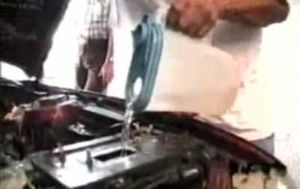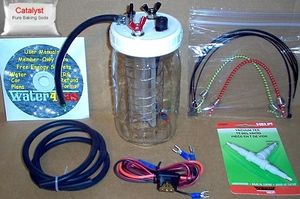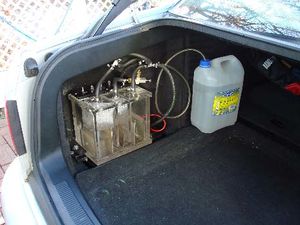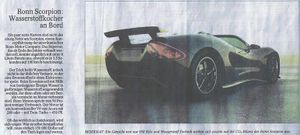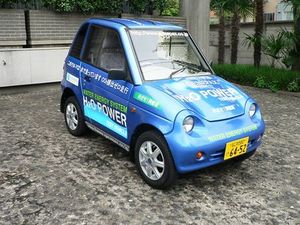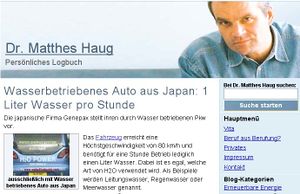Water-fuelled car
Article is in translation and unfinished
A Water-fuelled car is according to supporters of free energy a hypothetical car that works with just water as fuel. There are no serious reports known of a successful water-fuelled car concept. A water-fuelled car must not be confused with hydrogen vehicles, which carry tanks of hydrogen to burn it with oxygen as fuel.
Alleged functional principle
All water-fuelled car models that were thematised so far "work" on the same principle: Carried along water is transformed using energy consuming electrolysis in hydrogen and oxygen and a normal internal combustion engine is then run with oxyhydrogen. The necessary electrical energy to create the oxyhydrogen with a small electrolysis cell is taken from the alternator and/or a car battery. Such a construction can work for some time – till the car battery is empty and all Oxyhydrogen is used up.
Since the electrical energy taken from the alternator would have to surpass the engine output, the missing energy to keep the engine running for a long time has to be supplied by scientific unknown esoteric hypothesis. Space Energy and Neutrinos (Neutrinolysis) are under discussion in supporting circles of water-fuelled cars.
Refitting kits for regular engines
Shady profiteers sell refitting kits (e.g. at eBay) which should make it possible to convert a car with a regular combustion engine to a water-fuelled car. To allow electrolysis a chemical agent, e.g. baking powder, is added.
The company Fiss-Management from Erfurt, Germany (damaged reputation because of a warning of the Federal Agency for Financial Market Supervision and of a Test-journal and probably a one-man-show) offers a on-board-electrolysis cell for passenger cars (2,260 €) and trucks (9,520 €). See also: Spritsparkarte
Power efficiency of on-board electrolysis
The efficiency of an alternator is usually clearly lower than the efficiency of optimized generators, moreover alternators have to provide electrical output at various and an often unfavourable rotational speed. The efficiency lies in a range of 50 to 62 percent.[1] Optimal electrolysis at room temperature (platinum electrodes and optimal potential but not more than 14V) has a maximal efficiency of ≈60%. Appliance of special high temperature electrolysis at about 800 degrees allows to reach up to 98% efficiency. For simple electrolysis cells, which are sold as extensions, it is about 30%. The efficiency of creating hydrogen with gasoline as fuel is therefore approximately 8%-20%. Using oxyhydrogen as fuel(Brown's Gas) for the engine does not give 100% either but is similar to the efficiency of using gasoline. Otto-motors reach only a power efficiency of about 30-40%. Moreover problems arise due to a higher combustion temperature of hydrogen and connected to it a higher emission of nitric oxides.[2].
The higher temperature also causes higher abrasion of the engine and a higher load for the cooling system; the increased need for repairs and spare parts has a negative impact on the environmental record of the system.
Conclusion: To try to operate a internal combustion engine with extra oxyhydrogen which is created on-board through electrolysis leads to higher fuel consumption. The more oxyhydrogen is created, the more costly it is for the driver. Running a car just with oxyhydrogen created by above device leads to 4-5 times more fuel consumption:
- Kinetic energy created by gasoline combustion has efficiency < 40 %
- the rotating alternator has an efficiency of less than 62%
- creating hydrogen through electrolysis has an efficiency of about 60% (special, optimized electrolysis cell)
- Burning hydrogen with oxygen gives an efficiency < 40 %
Only about 0,4 x 0,62 x 0,6 x 0,4 = 6% (maybe 10% at max.) of the energy of the gasoline is used. Combustion of just gasoline gives an efficiency of 40% at max. Operation a car just with oxyhydrogen from the on-board electrolysis consumes at least 4 to 5 times as much. Massive usage of this principle (even mixed) would have catastrophic impact from an ecological point of view due to higher CO2-emissions and have higher costs.
A pure hydrogen operation is illusory with the offered kits since a normal alternator is not even rudimentary constructed to provide enough output for a small car: The maximal output of an alternator (for large executive cars) is about 3,000 W which corresponds roughly to the drive train of a small scooter.
The external production of hydrogen gas in industrial electrolysis facilities to supply all cars would please only the nuclear energy and brown coal industry since the additionally necessary huge amounts of electrical energy cannot be provided by renewable energy sources. Problems with storing hydrogen and high losses add to this. Hydrogen can - unlike gasoline - diffuse through normal tank walls: After some time, the tank is empty...
Clean World Energies and their H-Reaktor
The Jülicher company Clean World Energies GmbH advertises their so called "H-Reactors" and "Super - Cubes" in Germany. They are said to decrease the fuel consumption and pollution of car engines through addition of hydrogen. The electrical energy to power their "Electrolyseur" is taken from the on-board car battery.
Ronn Motor Company
Genepax
Wasserauto nach Daniel Dingel
Weblinks
- http://en.wikipedia.org/wiki/Water-fuelled_car
- Water-fueled car and Konstantin Meyl
- http://www.autobloggreen.com/2008/08/04/why-on-board-hydrogen-generators-wont-boost-your-mileage/

